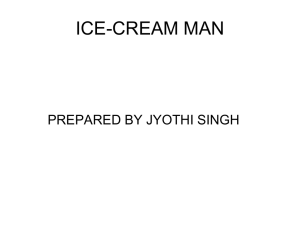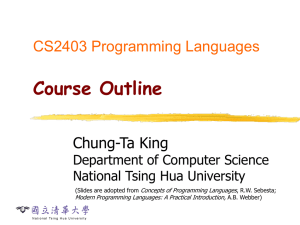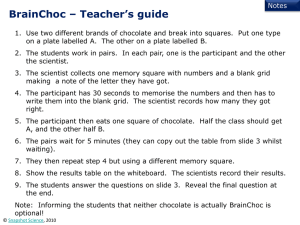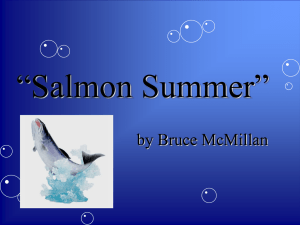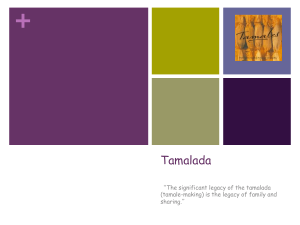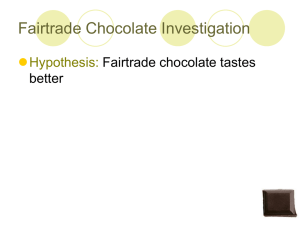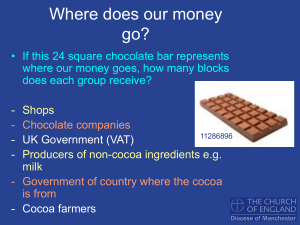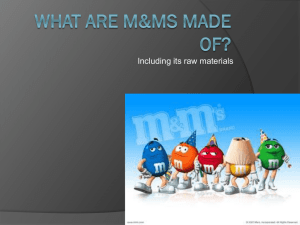Slides
advertisement
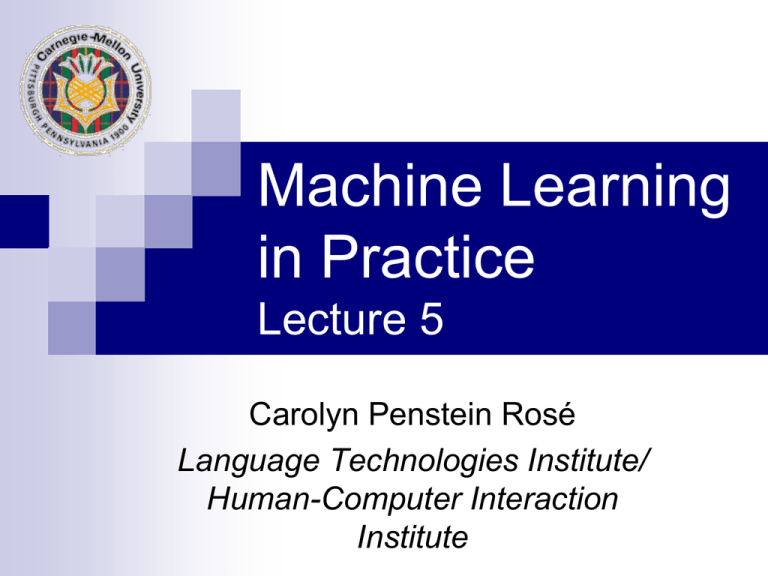
Machine Learning
in Practice
Lecture 5
Carolyn Penstein Rosé
Language Technologies Institute/
Human-Computer Interaction
Institute
Plan for the Day
Announcements
Assignment
3
Project update
Quiz 2
Naïve Bayes
Naïve Bayes
Decision Tables vs Decision Trees
Closed World
Assumption
Every
Only
case
enumerated
No generalization
except by limiting
number of attributes
1R algorithms
produces the simplest
possible Decision
Table
Open World
Assumption
examine some
attributes in particular
contexts
Uses majority class
within a context to
eliminate closed world
requirement
Divide and Conquer
approach
Decision Tables vs Decision Trees
Closed World
Assumption
Every
Open World
Assumption
Only
case
enumerated
examine some
attributes in particular
contexts
No generalization
Uses majority class
except by limiting
within a context to
number of attributes
eliminate closed world
1R algorithms
requirement
http://aidb.cs.iitm.ernet.in/cs638/questionbank_files/image004.jpg
produces the simplest
possible Decision
Table
Divide and Conquer
approach
Decision Tables vs Decision Trees
Closed World
Assumption
Every
Only
case
enumerated
No generalization
except by limiting
number of attributes
1R algorithms
produces the simplest
possible Decision
Table
Open World
Assumption
examine some
attributes in particular
contexts
Uses majority class
within a context to
eliminate closed world
requirement
Divide and Conquer
approach
Decision Tables vs Decision Trees
Closed World
Assumption
Every
Only
case
enumerated
No generalization
except by limiting
number of attributes
1R algorithms
produces the simplest
possible Decision
Table
Open World
Assumption
examine some
attributes in particular
contexts
Uses majority class
within a context to
eliminate closed world
requirement
Divide and Conquer
approach
Decision Tables vs Decision Trees
Closed World
Assumption
Every
Only
case
enumerated
No generalization
except by limiting
number of attributes
1R algorithms
produces the simplest
possible Decision
Table
Open World
Assumption
examine some
attributes in particular
contexts
Uses majority class
within a context to
eliminate closed world
requirement
Divide and Conquer
approach
Decision Tables vs Decision Trees
Closed World
Assumption
Every
Only
case
enumerated
No generalization
except by limiting
number of attributes
1R algorithms
produces the simplest
possible Decision
Table
Open World
Assumption
examine some
attributes in particular
contexts
Uses majority class
within a context to
eliminate closed world
requirement
Divide and Conquer
approach
Weights Versus Probabilities:
A Historical Perspective
Artificial intelligence is about separating
declarative and procedural knowledge
Algorithms can reason using knowledge
in the form of rules
E.g.,
expert systems, some cognitive models
This can be used for planning,
diagnosing, inferring, etc.
Weights Versus Probabilities:
A Historical Perspective
But what about reasoning under
uncertainty?
Incomplete
knowledge
Errors
Knowledge
with exceptions
A changing world
Rules with Confidence Values
Will Carolyn eat the chocolate?
Positive
evidence
Carolyn usually eats what she likes. (.85)
Carolyn likes chocolate. (.98)
Negative
Evidence
Carolyn doesn’t normally eat more than one dessert
per day. (.75)
Carolyn already drank hot chocolate. (.95)
Hot chocolate is sort of like a dessert. (.5)
How do you combine positive and negative
evidence?
What is a probability?
You have a notion of an event
Tossing
How many things can happen
Heads,
a coin
tails
How likely are you to get heads on a
random toss?
50%
Probabilities give you a principled way of
combining predictions
How
likely are you to get heads twice in a row?
.5 * .5 = .25
Statistical Modeling Basics
Rule and tree based methods use
contingencies between patterns of attribute
values as a basis for decision making
Statistical models treat attributes as
independent pieces of evidence that the
decision should go one way or another
Most of the time in real data sets the values
of the different attributes are not
independent of each other
Statistical Modeling Pros and Cons
Statistical modeling people argue that
statistical models are more elegant than other
types of learned models because of their
formal properties
You
can combine probabilities in a principled way
You can also combine the “weights” that other
approaches assign
But it is more ad hoc
Statistical Modeling Pros and Cons
Statistical approach depends on
assumptions that are not in general true
In practice statistical approaches don’t work
better than “ad-hoc” methods
Statistical Modeling Basics
Even without features you can make a
prediction about a class based on prior
probabilities
You
would always predict the majority class
Statistical Modeling Basics
Statistical approaches balance evidence
from features with prior probabilities
Thousand
feet view: Can I beat performance
based on priors with performance including
evidence from features?
On very skewed data sets it can be hard to
beat your priors (evaluation done based on
percent correct)
Basic Probability
If you roll a pair of dice, what is the
probability that you will get a 4 and a 5?
Basic Probability
If you roll a pair of dice, what is the
probability that you will get a 4 and a 5?
1/18
Basic Probability
If you roll a pair of dice, what is the
probability that you will get a 4 and a 5?
1/18
How did you figure it out?
Basic Probability
If you roll a pair of dice, what is the
probability that you will get a 4 and a 5?
1/18
How did you figure it out?
How many ways can the dice land?
Basic Probability
If you roll a pair of dice, what is the
probability that you will get a 4 and a 5?
1/18
How did you figure it out?
How many ways can the dice land?
How many of these satisfy our constraints?
Basic Probability
If you roll a pair of dice, what is the
probability that you will get a 4 and a 5?
1/18
How did you figure it out?
How many ways can the dice land?
How many of these satisfy our constraints?
Divide ways to satisfy constraints by
number of things that can happen
Basic Probability
What if you want the first die to be 5 and
the second die to be 4?
Basic Probability
What if you want the first die to be 5 and
the second die to be 4?
What if you know the first die landed on 5?
Computing Conditional Probabilities
Computing Conditional Probabilities
What is the probability of
high humidity?
Computing Conditional Probabilities
What
What is
is the
the probability
probability of
of
high
high humidity
humidity?given that
the temperature is cool?
How do we train a model?
How do we train a model?
For every value of every
feature, store a count.
How many times do you
see Outlook = rainy?
How do we train a model?
For every value of every
feature, store a count.
How many times do you
see Outlook = rainy?
What is P(Outlook = rainy)?
We also need to know what evidence each
value of every feature gives of each
possible prediction (or how typical it would
be for instances of that class)
What is P(Outlook = rainy | Class = yes)?
How do we train a model?
We also need to know what evidence each
value of every feature gives of each
possible prediction (or how typical it would
be for instances of that class)
What is P(Outlook = rainy | Class = yes)?
How do we train a model?
Store counts on
(class value, feature value)
pairs
How many times is
Outlook = rainy
when class = yes?
We also need to know what evidence each
value of every feature gives of each
possible prediction (or how typical it would
be for instances of that class)
What is P(Outlook = rainy | Class = yes)?
How do we train a model?
Store counts on
(class value, feature value)
pairs
How many times is
Outlook = rainy
when class = yes?
Likelihood that play = yes if Outlook = rainy =
Count(yes & rainy)/ Count(yes) * Count(yes)/Count(yes or no)
Now try to compute likelihood play = yes for Outlook =
overcast,
Temperature
= hot,
Humidity
= high,
How
do
we
train
a
model?
Windy = FALSE
Combinations of features?
E.g., P(play = yes | Outlook = rainy &
Temperature = hot)
Multiply conditional probabilities for each
predictor and prior probability of predicted class
together before you normalize
P(play
= yes | Outlook = rainy & Temperature = hot)
Likelihood of yes = Count(yes & rainy)/ Count(yes) *
Count(yes & hot)/ Count(yes) * Count(yes)/Count(yes
or no)
After you compute the likelihood of yes and likelihood
of no, you will normalize to get probability of yes and
probability of no
Unknown Values
Not a problem for Naïve Bayes
Probabilities computed using only the
specified values
Likelihood that play = yes when Outlook =
sunny, Temperature = cool, Humidity =
high, Windy = true
2/9
* 3/9 * 3/9 * 3/9 * 9/14
If Outlook is unknown, 3/9 * 3/9 * 3/9 * 9/14
Likelihoods will be higher when there are
unknown values
Factored
out during normalization
Numeric Values
List values of numeric feature for all class features
Values
Compute Mean and Standard Deviation
Values
for play = no: 85, 80, 65, 72, 71
= 74.6, = 7.89
Compute likelihoods
f(x)
for play = yes: 83, 70, 68, 64, 69,75, 75, 72, 81
= 73, = 6.16
Values
for play = yes: 83, 70,68, 64, 69, 75, 75, 72, 81
= [1/sqrt(2 )]e
(x- )2/2 2
Normalize using proportion of predicted class
feature as before
Bayes Theorem
How would you compute the likelihood that
a person was a bagpipe major given that
they had red hair?
Bayes Theorem
How would you compute the likelihood that
a person was a bagpipe major given that
they had red hair?
Could you compute the likelihood that a
person has red hair given that they were a
bagpipe major?
Bayes Theorem
How would you compute the likelihood that
a person was a bagpipe major given that
they had red hair?
Could you compute the likelihood that a
person has red hair given that they were a
bagpipe major?
Another Example Model
Compute conditional probabilities for each attribute
value/class pair
P(B|A) = Count(B&A)/Count(A)
P(coffee ice-cream | yum) = .25
P(vanilla ice-cream | yum) = 0
@relation is-yummy
@attribute ice-cream {chocolate, vanilla, coffee, rocky-road, strawberry}
@attribute cake {chocolate, vanilla}
@attribute yummy {yum,good,ok}
@data
chocolate,chocolate,yum
vanilla,chocolate,good
coffee,chocolate,yum
coffee,vanilla,ok
rocky-road,chocolate,yum
strawberry,vanilla,yum
Another Example Model
What class would you assign to strawberry ice cream with
chocolate cake?
Compute likelihoods and then normalize
Note: this model cannot take into account that the class might
depend on how well the cake and ice cream “go together”
@relation is-yummy
@attribute ice-cream {chocolate, vanilla, coffee,
rocky-road, strawberry}
@attribute cake {chocolate, vanilla}
@attribute yummy {yum,good,ok}
@data
chocolate,chocolate,yum
vanilla,chocolate,good
coffee,chocolate,yum
coffee,vanilla,ok
rocky-road,chocolate,yum
strawberry,vanilla,yum
What is the likelihood that
the answer is yum?
P(strawberry|yum) = .25
P(chocolate cake|yum) = .75
.25 * .75 * .66 = .124
What is the likelihood that
The answer is good?
P(strawberry|good) = 0
P(chocolate cake|good) = 1
0* 1 * .17 = 0
What is the likelihood that
The answer is ok?
P(strawberry|ok) = 0
P(chocolate cake|ok) = 0
0*0 * .17 = 0
Another Example Model
What about vanilla ice cream and vanilla cake
Intuitively, there is more evidence that the selected
category should be Good.
@relation is-yummy
@attribute ice-cream {chocolate, vanilla, coffee,
rocky-road, strawberry}
@attribute cake {chocolate, vanilla}
@attribute yummy {yum,good,ok}
@data
chocolate,chocolate,yum
vanilla,chocolate,good
coffee,chocolate,yum
coffee,vanilla,ok
rocky-road,chocolate,yum
strawberry,vanilla,yum
What is the likelihood that
the answer is yum?
P(vanilla|yum) = 0
P(vanilla cake|yum) = .25
0*.25 * .66= 0
What is the likelihood that
The answer is good?
P(vanilla|good) = 1
P(vanilla cake|good) = 0
1*0 * .17= 0
What is the likelihood that
The answer is ok?
P(vanilla|ok) = 0
P(vanilla cake|ok) = 1
0* 1 * .17 = 0
Statistical Modeling with Small
Datasets
When you train your model, how many
probabilities are you trying to estimate?
This statistical modeling approach has
problems with small datasets where not
every class is observed in combination with
every attribute value
What
potential problem occurs when you never
observe coffee ice-cream with class ok?
When is this not a problem?
Smoothing
One way to compensate for 0 counts is to
add 1 to every count
Then you never have 0 probabilities
But what might be the problem you still
have on small data sets?
Naïve Bayes with smoothing
@relation is-yummy
@attribute ice-cream {chocolate, vanilla, coffee,
rocky-road, strawberry}
@attribute cake {chocolate, vanilla}
@attribute yummy {yum,good,ok}
@data
chocolate,chocolate,yum
vanilla,chocolate,good
coffee,chocolate,yum
coffee,vanilla,ok
rocky-road,chocolate,yum
strawberry,vanilla,yum
What is the likelihood that
the answer is yum?
P(vanilla|yum) = .11
P(vanilla cake|yum) = .33
.11*.33* .66= .03
What is the likelihood that
The answer is good?
P(vanilla|good) = .33
P(vanilla cake|good) = .33
.33 * .33 * .17 = .02
What is the likelihood that
The answer is ok?
P(vanilla|ok) = .17
P(vanilla cake|ok) = .66
.17 * .66 * .17 = .02
Take Home Message
Naïve Bayes is a simple form of statistical
machine learning
It’s naïve in that it assumes that all
attributes are independent
In the training process, counts are kept that
indicate the connection between attribute
values and predicted class values
0 counts interfere with making predictions,
but smoothing can help address this
difficulty

